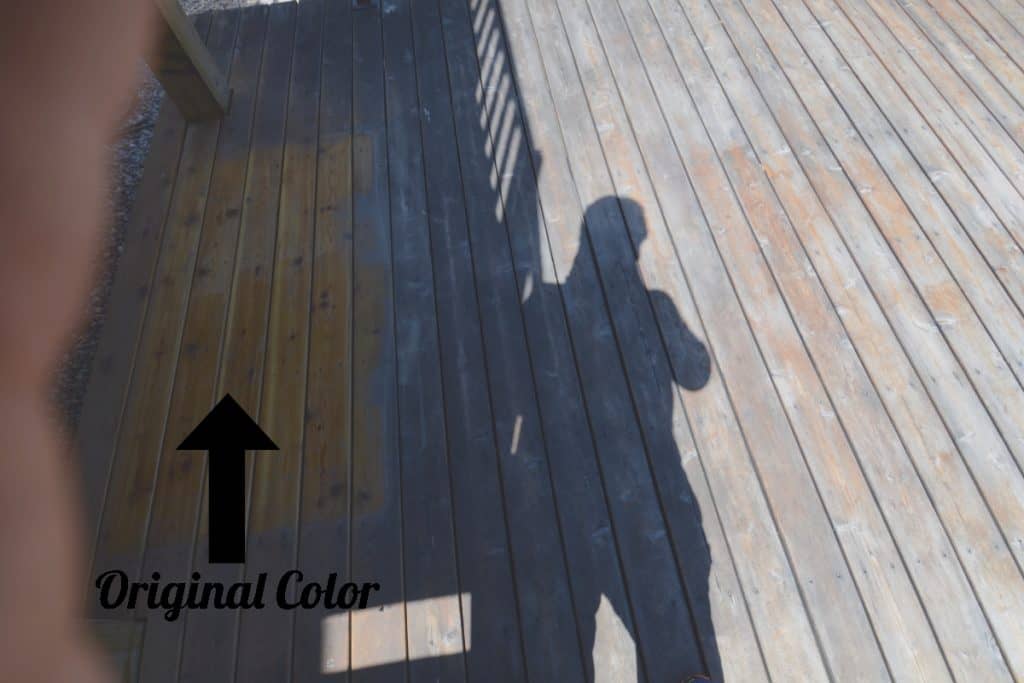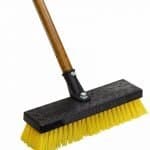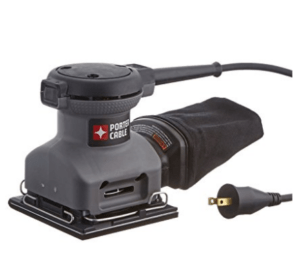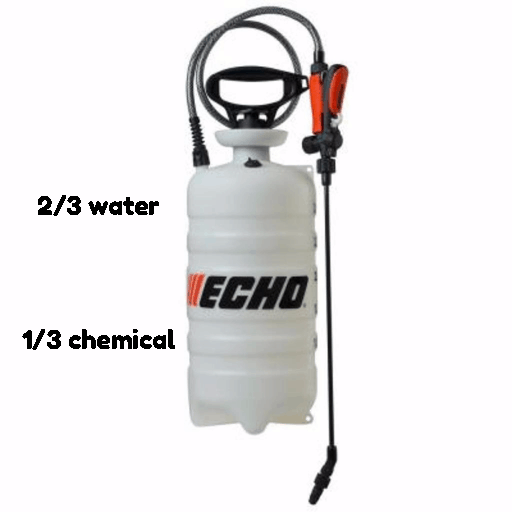Restoring A Cedar Deck From Start To Finish
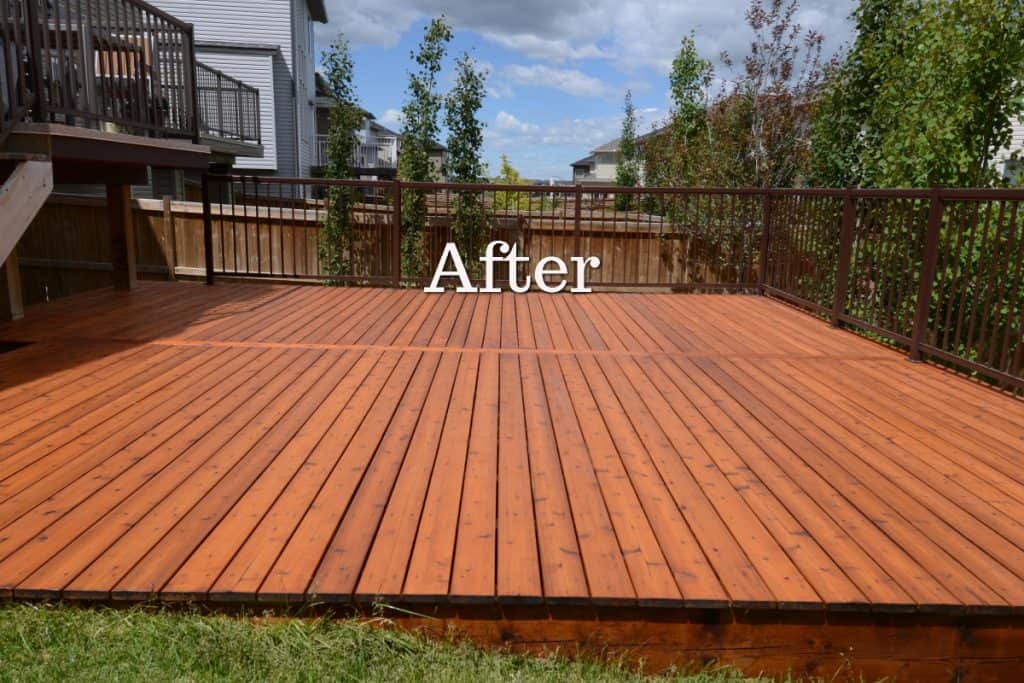
Introduction:
The homeowners were very unhappy with the weathered and dirty look of their cedar deck. It had taken on an almost charcoal-gray color in appearance. Plain and simple, it was dirty and the original stain had deteriorated!
When the deck was new, a coat of Sikkens Translucent Stain was applied in a color I'm going to guess was 'cedar'. It's impossible to know for sure. It has that orange-ish color that Sikkens is famous for. While the rest of the deck was dirty and grey, there was still a spot under the upper deck that had retained its original color because a plastic tool chest protected it against the elements. I'll drop a picture of this below because the difference was quite dramatic in appearance.
What happened to the deck to make it deteriorate so much?
Well, the homeowner said the only maintenance they did was apply a coat of linseed oil on it every year or two.
While Linseed oil may have some good preservative properties it does not offer any UV protection against sun damage. It also gets dirty faster because of the raw,oil-based finish.
On the other hand, if they had maintained the deck with a fresh coat of the Sikkens Stain every year the deck would obviously not be in this poor condition. The Sikkens Stain has Linseed oil as a component but it also has other chemicals that fortify it with UV protecting qualities.
Think of the Sikkens Stain as a sunscreen with UV protection. The Linseed oil that was used previously is like putting baby oil on your skin and expecting not to get a sunburn.
Again, if you want the luxurious look of a Sikkens Translucent Stain, there should be an expectation of a maintenance coat every few years. You don't have to go through this long restoration process again if the deck is maintained properly. All that is required is a quick clean and light sand before you apply another coat of the Sikkens Cetol SRD RE.
UPDATE: Since the writing of this article the parent company PPG has rebranded Sikkens under its Sico label. It is still called Proluxe Cetol SRD RE. In Calgary you can buy it at all Benjamin Moore stores as well as The Cedar Shop
Products & Tools Required For the Job
The decision was made to use Sikkens Proluxe: 'Cetol SRD RE Translucent Exterior Wood Finish'.The Homeowner chose the Sikkens "cedar" color which is similar to the original.
Sikkens Oil based stain will cover approximately 250 sq feet per gallon. The deck was about 450 sq feet so two (2) gallons was needed for the job. Only one coat is applied with this product.
The stripping process required three (3) Benjamin Moore products:
1) Clean
2) Restore
3) Brighten
To apply the chemicals a 3 Gallon garden sprayer was used with a flat tip. The mixture for each product was exactly 2/3 water and 1/3 chemical. That is a heavy concentration for this product. This was required because the deck was in really bad shape. You can dilute some of these products up to a 6/1 ratio of water to chemical. Drop cloths & plastic were used to protect the grass from the chemicals. You definitely want to use rubber gloves, rubber boots, eye protection, as well as hearing protection when doing this job. [The pressure washer can be quite loud.] A good quality dust mask is a must when sanding.
The 4th and final step of the prep work is sanding the deck. We used 1/4 sheet Porter Cable palm sanders. The sandpaper used was 50 grit and 80 grit. The full 8x11 sandpaper sheets were cut into 4 pieces. I'm guessing that 15 sheets of the 50 grit were used and 8 sheets of the 80 grit. In hindsight, it might have been more efficient to use Benjamin Moore's 'REMOVE' deck stripper instead of the RESTORE. This would have resulted in less sanding (with 100 grit) as a final step. With the deck that dark & dirty, it was difficult to determine how much of the finish had deteriorated.
I purchased a Deck scrub brush from Home Depot at a cost of $18.00 CAD...This brush has a sturdy pole handle that is permanently attached to the base for stability. The brush bristles were rugged and stayed firm. I highly recommend this scrub brush as it will last for many many years.
The gas powered pressure washer used was a Storm model with a 'Giant' brand pump. It was set at 2,000 PSI and a green tip was used. The fan width was almost the size of the floorboards (4")
For the staining, I purchased a 6" wide stain brush manufactured by Wooster. One of the benefits of this brush is that the handle can be removed and you can insert a broom handle in its place. I much prefer to stand up when staining a deck. For one thing, it's easier on your knees and back and you also have a longer reach. You can back brush half the deck board in a matter of seconds. This also prevents uneven finishes.
A second paint brush was used to cut-in around the railings. It was a 2.5" (angled) sash natural bristle brush.
Finally, a Leaf Blower was used to blow off the dust created by the sanding process. It's faster and does a much better job than a broom.
Step #1 Apply Benjamin Moore CLEAN
As you can see in the 'Before' picture above, this cedar deck was extremly dirty. This required an extra step in comparison to the typical deck stripping process. My paint rep at Benjamin Moore recommended a product called CLEAN. It comes in one gallon plastic containers and can be applied out of a plastic pail or with a garden sprayer. We used a Garden sprayer and chose a flat tip for application. The three gallon garden sprayer was filled with 2 gallons of water and one gallon of the CLEAN solution. This is a strong mixture and can be reduced to up to 6 parts water and one part of the Benjamin Moore CLEAN.
This approximately 22x20 deck had a board running perpindicular to the rest of the floor boards which divided it into 2 equal parts. Our method was to apply the solution to 3-4 of these 10' boards at a time. Allow it to set up for a few minutes and then scrub away with the deck brush. The agitation loosens up the dirt and grime and is then removed with a pressure washer a board a time. The flat tip on the pressure washer was almost the same width as the floor board. It is important to clean the sides of the board too because any remaining dirt or stain will be visible.
Step #2 Apply Benjamin Moore RESTORE
The second step is exactly the same as the first step but using a different solution called Benjamin Moore RESTORE. The deck was dry before we started the 2nd step because it was baking hot outside. We used the same 2/1 STRONG mixture of water to chemical ratio. You can mix an even stronger mixture of 1/2 and 1/2 if you prefer. This chemical will remove mildew & any discoloration on the deck. Make sure to rinse the garden sprayer clean before adding the restore solution.
- As the name implies, it "Restores" wood that has severely weathered
- This chemical has a Bleach-free formula. The manufacturer claims it's gentle to wood and the ecosystem.
- Ideal for treating mold and mildew.
Step #3 Apply Benjamin Moore BRIGHTEN
The third step is exactly the same as the first two-steps but the chemical solution used was Benjamin Moore 'BRIGHTEN'. Again, the garden sprayer was cleaned and filled with 2 parts water and one part Brighten. The brightener not only lightens the wood but it also neutralizes the previous chemical solution. It's critical to lower the pH after using RESTORE which is highly alkaline. Restore may cause darkening of the wood surface, especially redwood and cedar.
You still have to agitate the BRIGHTEN with a scrub brush, and either pressure wash or rinse it off with a garden hose. We used a pressure washer for faster results. After it dried the wood looked much brighter but we still found some spots of the old stain still present. Because we were using the same color as the original coating this didn't affect the final result. If you want to strip the old coating off completely Benjamin Moore has a chemical stripper called "REMOVE" which is basically a more potent version of the Restore.
- Brighten will remove rust stains and tannin discoloration.
- Cuts the "mill glaze" on new wood and allows the pores to open up for staining.
- Reverses the darkening effect caused by chemical reactions in Benjamin Moore Restore.
Apply Sikkens Stain
**Editors Note** Since the writing of this article a few years ago, Sikkens has been rebranded under the SICO name. The Proluxe SRD RE description has not changed. It's still the same product but relabeled. Curiously, the Sikkens name is still being used in the USA.
As stated above the stain we used is called "Sico Proluxe SRD RE". The color chosen was "CEDAR".
The weather was quite hot for a typical Calgary Spring day so we stained a 10' section of the deck floor at a time. The deck has a metal railing so the supporting feet had to be brushed in with a 2.5" natural bristle paint brush. For the rest of the job a 6" Wooster natural bristle deck brush was used. The brush handle is removable and a broom handle was inserted in its place. The stain was stirred frequently and poured into a plastic Simms brand roller tray. A paint tray is less likely to knock over than a typical one gallon cutting pale.
This translucent Oil-based stain has almost the consistency of water so one needs to be careful not to spill it. When applying, you hit the sides of the boards first with the brush and then fill in the rest. Ten feet of floorboard can be stained in a short period of time. It's important not to leave any streaks so it is advisable to back-brush the entire length before moving on to the next board. Do not apply it too thick because it may not dry completely. If you see puddles use your brush to remove the excess, or a wipe it off with a cotton rag.
The staining only took about 2.5 hours to complete. One coat is the manufacturer's recommendation. Again, do not overapply!
One last thing about Sikkens Stain. To maintain this beautiful look the deck should be recoated every year or two. Three years might be the max you can expect out of this stain. Two years is a good rule of thumb. You don't want to wait until there is visible deterioration and the deck is exposed to the elements. The old cliche "it's better to be safe than sorry" applies here. The aging or deterioration will vary depending on the amount of traffic a deck gets and the local climate. It's like applying sunscreen to protect the wood against further damage.
Two gallons was enough to cover this 450 sq foot deck. The manufacturer suggests coverage will be 150-250 sq feet/gallon on weathered and rough surfaces. For this job it averaged approximately 225 sq ft/gallon. For smooth surfaces, like hardwoods, you will see greater coverage. Coverage really depends on the application method, age of the deck, the porosity of the wood species, and what kind of condition it's in. I always estimate 200 sq feet per gallon for this deck coating applied to Cedar.

